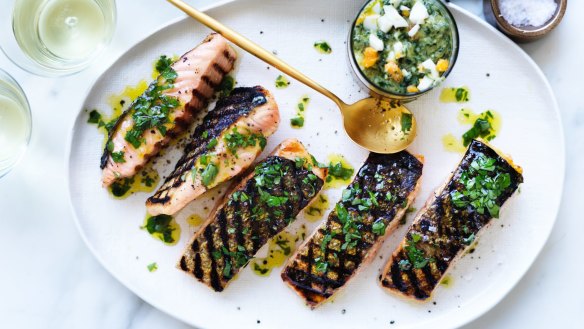The secret to perfect grilled fish

What's the secret to grilling fish without having it fall apart? G. Murphy
Start with good fish. I saw some fish at the supermarket recently that had been thawed for my convenience, then sat under lights for several days for my disappointment. The gaps between the muscle fibres were so large it looked like the fissures on a melting glacier. Take your fish. Pat it dry. Some chef chums let their fish sit on a rack to dry the cooking surfaces. Any moisture will cool the cooking surface and stop the necessary searing effect. Preheat the grill to high. Rub the grill with a little cooking oil using a paper towel or cloth. Allow to smoke. The heated oil polymerises, creating a non-stick layer. Turn down the heat to medium. Brush either side of the fish with a little oil and season with salt and pepper. Place the fish on the grill, skin side down. Initially it will stick. Then there comes a point, after about two to four minutes, when it naturally releases from the grill. You can check after two minutes by gently sliding a thin spatula under the fish. When released, gently turn the fish using two spatulas or a fish slice, not tongs. Cook for a further two to four minutes, depending on the thickness of the fillet. Remove from heat and allow to sit in a warm place for five minutes before serving. If your fish does break up, all is not lost. Allow it to cool enough to handle, remove the skin, break apart into flakes, lightly season and place it on top of a salad, which you can call "grilled fish salad" and start talking to your guests about the benefits of Omega 3.
Why does bread from most Italian bakeries, using just four ingredients, taste so good, while the bread in hot bread shops and supermarkets is so ordinary? John
Five ingredients: flour, water, salt, yeast and time. Great bread takes time. Slow development of the dough allows the yeasts to get stuck into the starch in the flour and break it down into simple sugars that it can turn into carbon dioxide, alcohol and a whole lot of other byproducts that add flavour. Some of the doughs made by those bakers can take half a day to ferment. Some old-fashioned bakers will even add some leftover dough to the new batch, increasing the complexity of the yeasts. Supermarket bread, and bread made by many of the hot-bread franchises, often uses premixes, with ingredients such as guar gum and emulsifiers such as sodium stearoyl lactylate and mono- and diglycerides of fatty acids, and even extra gluten. It takes less than an hour from adding the water to finished loaf. My advice: buy bread from an old-fashioned baker and not ones with ads on the TV.
Last week you said it is better to use weights and not cup measures when baking. How much does a cup of flour weigh? K. Poole
It depends on how tightly the cup is packed and whether you are using standard Australian cup measurements. A cup of flour weighs between 125g and 150g. A cup of sugar weighs about 200g, while a cup of the much less dense icing sugar weighs between 125g and 150g. That is why bakers and chefs use scales.
Send your vexing culinary conundrums to brainfood@richardcornish.com.au or tweet or insta @foodcornish.
- More:
- Food
- Brain food
